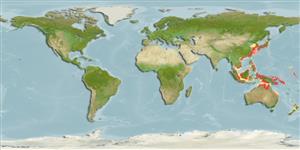Environment: milieu / climate zone / depth range / distribution range
Sinh thái học
Biển gần đáy. Tropical
Northwest Pacific: southern Japan to the China seas. Possibly in Thailand (Ref. 9918). Reported from India (Ref. 45255).
Length at first maturity / Bộ gần gũi / Khối lượng (Trọng lượng) / Age
Maturity: Lm 57.0, range 55 - 59 cm
Max length : 100.0 cm TL con đực/không giới tính; (Ref. 637)
Inhabits sandy or muddy bottom in shallow waters (Ref. 11230). Feeds on benthic animals. Spines covered with skin with poisonous glands. Ovoviviparous. Used as 'kamaboko' material (Ref. 637). Caught often by demersal trawl, trammel and gillnet fisheries, and occasionally using tangle nets.Utilized for its meat, but of limited value due to its typically small size (Ref.58048).
Life cycle and mating behavior
Chín muồi sinh dục | Sự tái sinh sản | Đẻ trứng | Các trứng | Sự sinh sản | Ấu trùng
Exhibit ovoviparity (aplacental viviparity), with embryos feeding initially on yolk, then receiving additional nourishment from the mother by indirect absorption of uterine fluid enriched with mucus, fat or protein through specialised structures (Ref. 50449). Distinct pairing with embrace (Ref. 205). Gives birth to ~3 pups; born between 20-22 cm WD (Ref.58048).
Masuda, H., K. Amaoka, C. Araga, T. Uyeno and T. Yoshino, 1984. The fishes of the Japanese Archipelago. Vol. 1. Tokai University Press, Tokyo, Japan. 437 p. (text). (Ref. 559)
IUCN Red List Status (Ref. 130435)
Human uses
Các công cụ
Special reports
Download XML
Các nguồn internet
Estimates based on models
Preferred temperature (Ref.
123201): 17.9 - 29.1, mean 28.1 °C (based on 1500 cells).
Phylogenetic diversity index (Ref.
82804): PD
50 = 0.5000 [Uniqueness, from 0.5 = low to 2.0 = high].
Bayesian length-weight: a=0.00776 (0.00352 - 0.01710), b=3.09 (2.89 - 3.29), in cm total length, based on LWR estimates for this (Sub)family-body shape (Ref.
93245).
Mức dinh dưỡng (Ref.
69278): 3.8 ±0.61 se; based on food items.
Thích nghi nhanh (Ref.
120179): Rất thấp, thời gian nhân đôi của chủng quần tối thiểu là hơn 14 năm (Fec assumed to be <10).
Fishing Vulnerability (Ref.
59153): High vulnerability (60 of 100).
